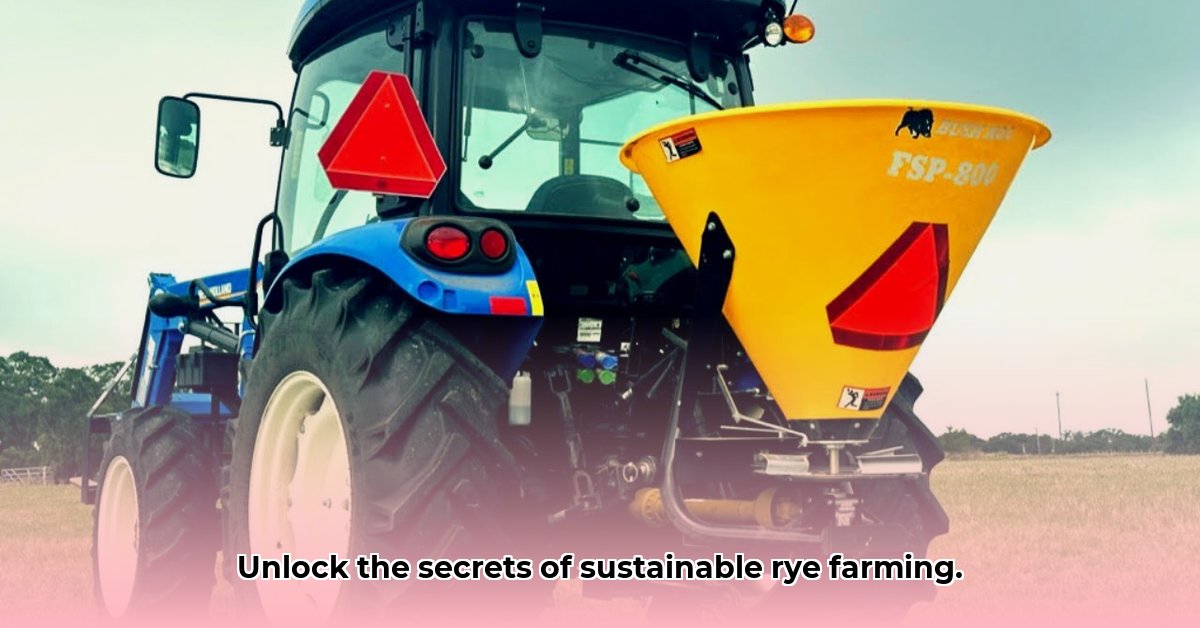
Understanding Your Rye Seed Needs: Soil, Climate, and Goals
Before diving into rye seed selection, a thorough assessment of your farm's unique characteristics is paramount. Different rye varieties thrive under specific conditions. Deep, well-drained soils may benefit from taller varieties, while lighter soils might prefer shorter, more robust types. Your climate plays a crucial role; choose winter-hardy varieties for colder regions and heat-tolerant options for warmer climates. Consulting your local agricultural extension office or experienced farmers in your area provides invaluable insights tailored to your specific location. This initial planning phase ensures optimized rye growth and maximum benefits. For additional resources on pasture seed, check out this helpful website.
Diving Deep into Rye Varieties: Tailoring to Your Farm
The diversity within rye seeds is often underestimated. Varieties are bred for specific purposes, impacting your choice. Grazing rye, for instance, differs significantly from rye intended for soil health improvement or grain production. Consider these key factors:
- Growth Rate: Rapidly maturing varieties are ideal for short-term soil improvement, while slower-growing options offer extended benefits. Consider your crop rotation timeline and the desired duration of rye cover.
- Growth Habit: Dense, low-growing rye creates a dense ground cover, while taller, more vigorous varieties excel in suppressing weeds and building soil biomass. Choose based on your specific needs.
- Disease Resistance: Selecting disease-resistant varieties minimizes crop losses and reduces reliance on chemical interventions, aligning with sustainable farming principles. This proactive step enhances the overall efficiency and resilience of your farming system.
Sourcing Quality Rye Seed: A Foundation for Success
Selecting a reputable seed supplier is crucial for achieving optimal results. Don't solely focus on price; prioritize quality. Look for certified seeds from established suppliers. This certification ensures seed purity and a high germination rate, directly translating to a more successful crop and minimizing potential setbacks. A high germination rate ensures a higher percentage of seeds will successfully sprout, leading to a denser, more effective cover crop.
Planting and Managing Your Rye: A Step-by-Step Approach
Successful rye cultivation involves careful planning and execution. Follow these steps for optimal results:
- Soil Preparation: Ensure a well-prepared seedbed with adequate moisture for optimal germination. Proper soil preparation is foundational to successful rye establishment.
- Planting Depth: Plant seeds at the recommended depth per the packaging instructions. Too shallow and seeds dry out, too deep and they may not germinate.
- Seeding Rate: Adhere to the recommended seeding rate for your chosen variety and local conditions to ensure adequate plant density for efficient soil coverage. This ensures proper ground cover and suppresses weed growth.
- Nutrient Management: Rye is not a heavy feeder; however, adding phosphorus in the fall can enhance growth in phosphorus-deficient soils. Consider a soil test to determine if supplemental Phosphorus is needed.
- Pest and Disease Monitoring: Regularly monitor your rye crop for any signs of pest or disease infestations. Early detection enables timely intervention, minimizing potential crop losses.
- Termination: For cover cropping, terminate the rye at the appropriate growth stage using tillage or a roller-crimper for no-till systems. Timing is critical to maximize soil benefits.
Leveraging Your Local Agricultural Supply Store
Your local agricultural supply store offers more than just seeds. They are valuable resources providing:
- Equipment: Access specialized equipment like seed drills for efficient and less labor-intensive planting. Seed drills place seeds consistently at the optimal depth, aiding germination.
- Expert Advice: Gain valuable insights on variety selection, planting techniques, and overall soil management strategies. Their experience with local conditions is invaluable.
- Supplemental Supplies: Source necessary fertilizers, pesticides (only when absolutely necessary), and other essential farm inputs. Having a single, reliable supplier streamlines your procurement process.
Sustainable Farming and Rye: A Powerful Partnership
Sustainable farming demands careful, informed decision-making. By understanding your farm's specific needs and selecting appropriate rye varieties and management practices, you build a more resilient and productive farming system. This integrated approach benefits your soil health, reduces reliance on synthetic inputs, and fosters long-term environmental sustainability.
"Rye cover cropping has played a significant role in improving our soil health and reducing our reliance on chemical fertilizers," says Dr. Emily Carter, Soil Scientist at the University of California, Davis. "The benefits extend beyond improved fertility; we've also seen a reduction in erosion and enhanced water infiltration."
"Using rye as a cover crop has been a game-changer for our farm," notes John Miller, a fifth-generation farmer in Iowa. "We're seeing healthier soil, bigger yields, and more consistent harvests. It's a sustainable approach that makes good economic and environmental sense."
The implementation of rye into sustainable farming practices is not without its challenges. However, the long-term environmental and economic benefits often outweigh the initial effort. Careful planning, access to quality resources, and a well-informed approach are key to integrating rye successfully into your system. Your local agricultural supply store and extension office are invaluable partners in this endeavor.